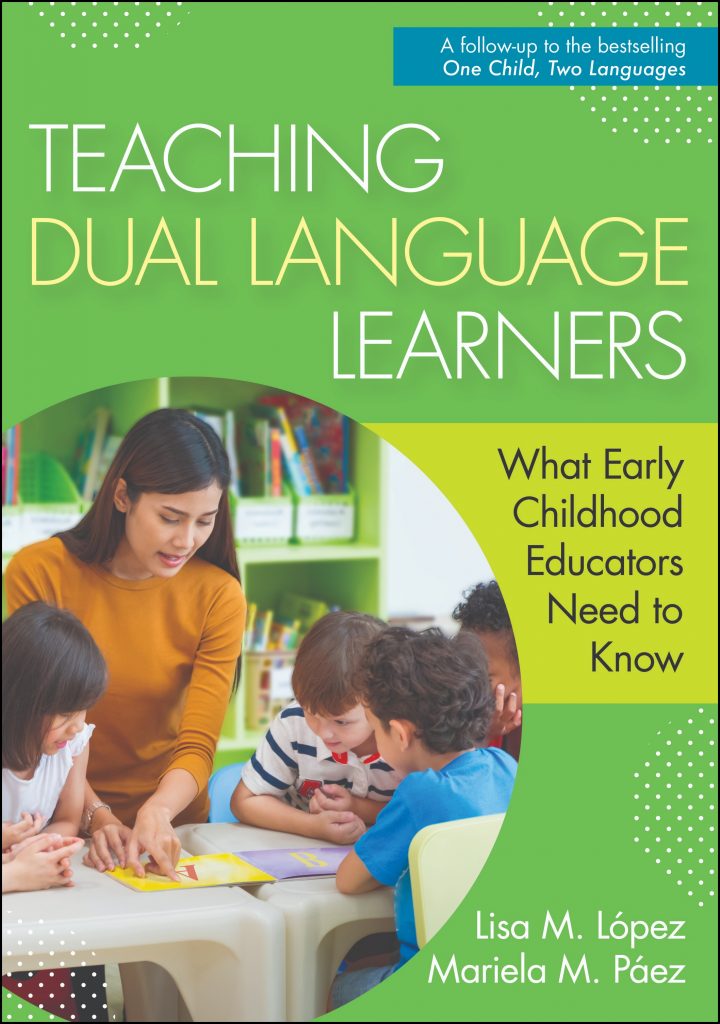10 Tips for Teaching Young Dual Language Learners Effectively

As schools and programs begin to return after the summer break, how can early educators make sure they’re creating a space that welcomes and supports the learning and development of young dual language learners (DLLs)? In this month’s article, you’ll get 10 tips on how you can prepare your classroom and curriculum to support young DLLs and help them succeed.
Early childhood learning environments are where young children begin to develop foundational school readiness skills—including language, early literacy, mathematics, executive functioning, and social-emotional skills—that will be essential for academic and social success in the elementary grades and beyond. The following strategies, excerpted and adapted from Teaching Dual Language Learners by Lisa López, Ph.D. & Mariela Páez, Ed.D., will help you teach these critical skills to all kids in a culturally and linguistically diverse classroom.
Introduce and reinforce key skills in the child’s home language.
It might seem logical to focus mainly on teaching dual language learners school readiness skills in English. But according to research and the 2016 Head Start Program Performance Standards (Office of Head Start, 2016), early childhood programs should introduce school readiness skills in the children’s home language, too. That’s because many of the underlying skills children need are uniform across different languages, and learning them in one language will boost the development of the other.
Matching DLLs with a teacher of the same ethnicity and/or cultural background is the easiest way to introduce skills in their home language, but the reality of today’s increasingly diverse classrooms means it’s often not possible to have a teacher who speaks the same home language as all of their dual language learners. The good news is that monolingual teachers can still promote language development in their linguistically diverse students by learning key words in the child’s home language and making an effort to educate themselves on the child’s language and culture.
Design play-based projects that focus on language interactions.
 Play-based activities—especially in the context of themed projects built around children’s interests—are an ideal way to engage DLL children and help them reach developmental and early academic goals. Here’s an example inspired by a recent study: develop a play-based unit on superheroes in your diverse classroom, and make it an opportunity to learn about language and social-emotional skills, too. Start by reading a poem and a book about superpowers, with the goal of introducing the concepts of pretend abilities (superpowers) and real-life abilities. Extend the definition of “superpowers” to include real-life prosocial actions, such as helping others, showing kindness, using your words, and sharing. Then plan superhero-themed activities involving small-group interactions (a storyboard with action heroes), one-on-one projects (individual portraits of children’s superpowers and qualities), and sociodramatic play (setting up an area with costumes).
Play-based activities—especially in the context of themed projects built around children’s interests—are an ideal way to engage DLL children and help them reach developmental and early academic goals. Here’s an example inspired by a recent study: develop a play-based unit on superheroes in your diverse classroom, and make it an opportunity to learn about language and social-emotional skills, too. Start by reading a poem and a book about superpowers, with the goal of introducing the concepts of pretend abilities (superpowers) and real-life abilities. Extend the definition of “superpowers” to include real-life prosocial actions, such as helping others, showing kindness, using your words, and sharing. Then plan superhero-themed activities involving small-group interactions (a storyboard with action heroes), one-on-one projects (individual portraits of children’s superpowers and qualities), and sociodramatic play (setting up an area with costumes).
During a themed unit like this one, use the following strategies to meet the needs of dual language learners:
- Use explicit vocabulary instruction to help DLL children learn new words
- Support children’s language learning by using repetition and modeling of new words
- Supplement spoken words with gestures, visual aids, and props
- Interact with children in a purposeful, consistent, and firm way to support children’s positive behaviors
- During choice time and sociodramatic play, encourage the kind of sustained back-and-forth conversations that build language skills
- Pair DLL children with peers who speak English as a first language to reinforce development of skills in English during activities
Rethink your whole-group time.
Sometimes it’s important to gather the whole class for a morning message or shared book reading. But keep in mind that DLLs who struggle with English may not get very much out of traditional whole-group time. Try these strategies instead:
- Limit the amount of time spent in whole group. In a study of preschool classrooms serving DLLs, López and colleagues (2017) found that the children were spending about one third of their morning in whole-group time. Try to reduce the time you spend as a large group, and think about which activities can be reimagined, shortened, or done in smaller groups instead.
- Pair DLL children with a buddy and do “turn and talk” activities. Have children share with a buddy instead of the entire group, pairing DLL students with another child who speaks their home language whenever possible. Letting DLLs participate by using the language they’re most comfortable speaking (regardless of activity) will increase their self-confidence and help lay the groundwork for successful language acquisition.
- Encourage prereading of books. Prereading books with a DLL child in their home language makes it easier for them to follow along with the story and learn new vocabulary words.
Make the most of small-group and one-to-one activities.
 Both small-group time and one-to-one activities make it easier to address the specific needs of individual DLL children. If one of the teachers speaks the home language of the children, small-group activities provide a good opportunity to preread a book in the home language, preteach thematic content before it’s introduced to the whole class, and focus on building literacy skills in the home language that children will be able to transfer once they have sufficient vocabulary in English.
Both small-group time and one-to-one activities make it easier to address the specific needs of individual DLL children. If one of the teachers speaks the home language of the children, small-group activities provide a good opportunity to preread a book in the home language, preteach thematic content before it’s introduced to the whole class, and focus on building literacy skills in the home language that children will be able to transfer once they have sufficient vocabulary in English.
For DLL learners who may need extra help, one-to-one activities are also valuable and can be used to scaffold language during play, teach math skills, or boost language skills using developmentally appropriate technology tools in the child’s home language. Teachers are strongly encouraged to learn some key words in a DLL child’s home language, but technology tools can be a great way for DLLs to continue expanding their first language skills when their teacher does not speak their home language.
Build in supports for metalinguistic skills.
Metalinguistic skills are early literacy skills that develop once a child begins to understand how language works. One example of an important preliteracy skill is the ability to determine that two words start with the same sound. Children who are exposed to multiple languages develop metalinguistic skills earlier than children exposed to only one language. If possible, teach preliteracy skills to DLL students in their home language, and they’ll be able to transfer those skills to the community language when they’re ready.
To support metalinguistic skills, talk about the similarities and differences between languages spoken in your classroom. Try the following strategies:
- Read books in different languages and highlight the unique features of each language
- Sing songs and read poems that expose children to the sounds of multiple languages
- Introduce vocabulary words in multiple languages, especially words that children know from their home languages
- Listen to children and adults narrating stories that show aspects of different cultures
Build background knowledge.
 One of the key elements in reading comprehension is background knowledge, an understanding of basic concepts that can also be culturally specific. You can help broaden the background knowledge of DLLs—and all young children—by introducing them to different cultural traditions. Build background knowledge into your early childhood learning environment by going on both virtual and real field trips, taking nature walks, inviting classroom guests to do show-and-tell presentations, and transforming classroom centers based on whatever subject you’re currently covering (e.g., pet store, pet groomers, pet obedience school, pet day care, veterinarian). These experiences will help invest DLL children with the contextual knowledge to comprehend English narratives presented orally and in print.
One of the key elements in reading comprehension is background knowledge, an understanding of basic concepts that can also be culturally specific. You can help broaden the background knowledge of DLLs—and all young children—by introducing them to different cultural traditions. Build background knowledge into your early childhood learning environment by going on both virtual and real field trips, taking nature walks, inviting classroom guests to do show-and-tell presentations, and transforming classroom centers based on whatever subject you’re currently covering (e.g., pet store, pet groomers, pet obedience school, pet day care, veterinarian). These experiences will help invest DLL children with the contextual knowledge to comprehend English narratives presented orally and in print.
Teach vocabulary in both languages.
Because vocabulary doesn’t transfer across languages, it’s essential for DLL children to develop vocabulary skills in English while continuing to learn new words in their home language. For example, during a conversation about baking a cake, a DLL child might say the word “torta” in Spanish or “dàngāo” in Mandarin instead of saying “cake,” giving the teacher an opportunity to follow up by providing the child with the English word, too.
Keep in mind that DLLs need to be presented with new vocabulary words in context and provided with ongoing opportunities to practice these new words. Try introducing new vocabulary words in small groups with accompanying pictures or concrete examples, giving DLL children a chance to think about words in their home language and make connections between what they know and the new information being presented. Once new words have been introduced, read books that include the words during small or whole group time, and create opportunities for DLLs to practice the words during center time.
Use scaffolds during book reading.
 All young children benefit from scaffolds during book reading, but DLL children are especially well-served when teachers point with a finger to certain words, ask questions, and run a finger along the text. For example, if you were doing a read-aloud of the book The Dot (Reynolds, 2003), you could begin by showing the children the cover of the book and ask them the following questions: Who is the author of the book? Is there an illustrator for the book? What is the title of the book? Where should we start reading? After talking about some of the children’s ideas, start reading the book and draw connections between the content of the book and your previous discussion. Afterwards, meet with DLLs for further discussion and a dot-drawing activity. Let your DLL students hold the book and point to different sections as they engage in the activity. This sort of small-group interaction gives teachers the opportunity to assess DLL children’s understanding of the book and provide scaffolds accordingly.
All young children benefit from scaffolds during book reading, but DLL children are especially well-served when teachers point with a finger to certain words, ask questions, and run a finger along the text. For example, if you were doing a read-aloud of the book The Dot (Reynolds, 2003), you could begin by showing the children the cover of the book and ask them the following questions: Who is the author of the book? Is there an illustrator for the book? What is the title of the book? Where should we start reading? After talking about some of the children’s ideas, start reading the book and draw connections between the content of the book and your previous discussion. Afterwards, meet with DLLs for further discussion and a dot-drawing activity. Let your DLL students hold the book and point to different sections as they engage in the activity. This sort of small-group interaction gives teachers the opportunity to assess DLL children’s understanding of the book and provide scaffolds accordingly.
Encourage early writing skills.
Be sure to encourage DLL children’s first attempts at writing, which may very well involve their home language skills as they naturally start to write more familiar sounds and words. You can also help make critical connections between spoken and written language for a DLL student by writing down a story dictated by the child and reading it back to them. For at-home support, encourage parents and caregivers to read to their child and provide activities in multiple languages so families can help nurture early writing skills away from the classroom.
Incorporate and support the child’s home languages.
Supporting home language skills is one of the most effective ways to boost the learning of a second language for young children. It’s important to expose DLLs to English and their home language in thoughtful and strategic ways; mixing languages without intentional planning could lead to a DLL child making progress only in their strongest language. Other key strategies—which can be adapted to each DLL student’s level of proficiency—include:
- Using home languages in whole-group conversations to make DLL children feel comfortable and competent
- Enriching whole-group experiences by using the home language and asking students to share in their home language
- Switching from one language to the other (if you know the child’s home language) as a scaffolding strategy when working one-to-one or in small groups
- Designing specific activities that include teaching in the home language
- Incorporating songs and rhymes in the children’s home languages (families or caregivers can serve as great resources for providing examples of songs that promote sound and rhyme awareness)
Because there are more linguistically diverse learners than ever before in early childhood settings, educators need to prioritize the teaching and engagement of children whose home language differs from that of the rest of the class. Use the practical strategies in this article to boost language and other key skills for DLL children and help pave the way toward a successful future.
Learn more about Teaching Dual Language Learners
Extending the groundbreaking work of Patton O. Tabors and ideal for use as a textbook or in‐service guide, this concise book compiles everything teachers need to know about working with young DLLs—and setting them up for a lifetime of school success.


